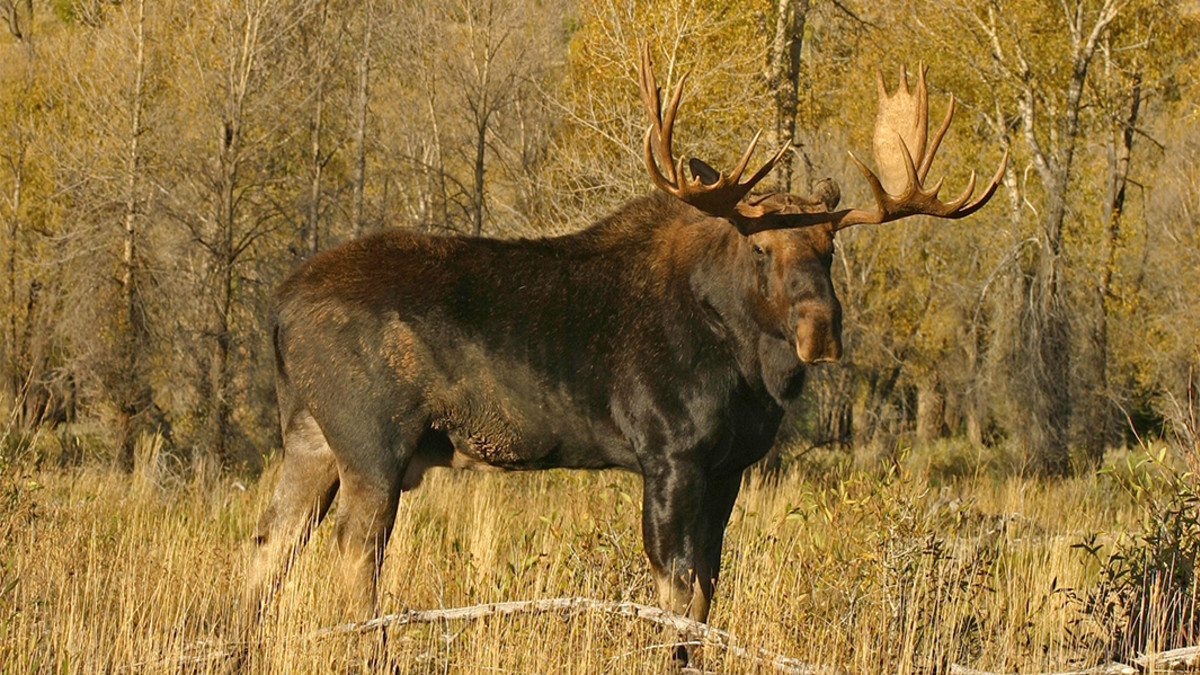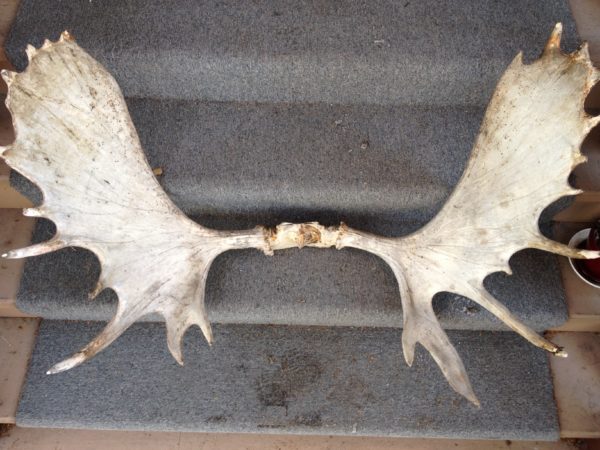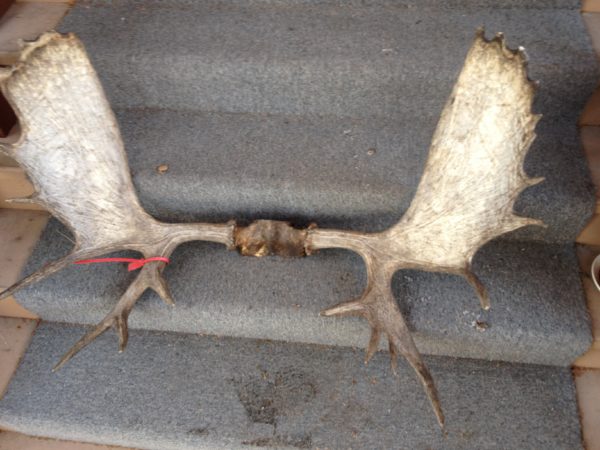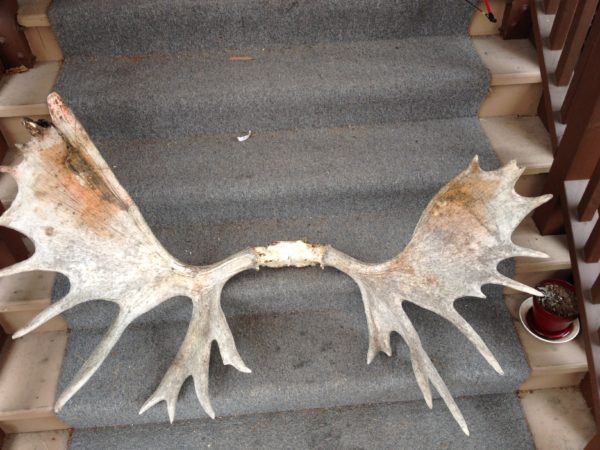
Moose are huge and excellent to eat. Once you have successfully put a moose on the ground from a hunt, you’ve earned yourself a year’s worth of wild game meals that are unsurpassed in quality.
For many hunters who live in moose country, where the animal is associated with abundance and good living, the fall hunting season is incomplete without putting a moose in the freezer. Moose have fantastic trophy value as well. A big bull moose can carry more pounds of antler than any other antlered game in the world, sets of antlers spreading out to widths of 5 feet are not uncommon.
When you hang a set of these antlers over your garage door, you’ve got a permanent reminder of a difficult task that was undertaken and accomplished. And “difficult” is the perfect word to describe a moose hunt. Traveling in moose country can be extremely tough due to thick vegetation and abundant water.
Finding the Beasts
Moose can also be frustrating to find. While their size would suggest an animal that’s easy to locate, they are good at vanishing into thicket timber and brush where you can’t see more than 20 or 30 yards ahead of you. And because they often like to feed in these same thickets, they can stay hidden for days on end. But the really tough thing about moose hunting is dealing with the animal once it’s down.
The carcasses are massive and hard to maneuver. Butchering a moose can be a daunting task for the uninitiated, and packing it out can be even worse. Many hunters have suffered sprained joints and torn ligaments from trying to pack moose meat in wet, boggy country. Before heading out on any moose hunt, ask yourself if you and your companions are committed to seeing it through to the end, no matter what. If the answer is yes, you’re in for a rewarding adventure.
Scientific Name
Alces alces
A.K.A.
There is only one species of North American moose, though hunters typically recognize either three or four varieties. The largest is the “Alaskan” or “Yukon” variety that occurs in Alaska, the western Yukon, and northwestern British Columbia. The second largest variety is the Canadian moose, which some divide further into the Northwestern and Eastern varieties. The Northwestern variety occurs across the northern portions of Minnesota, Wisconsin, and Michigan, as well as the bulk of Canada, excluding central Ontario and the Maritime Provinces. The Eastern moose is found in the northeastern U.S. as well as the Maritime Provinces westward to central Ontario. The smallest variety is the Shiras moose, which occurs only in the mountain states of the Western U.S. as well as in small portions of southeastern British Columbia and southwestern Alberta.
Bar Room Banter
While the classic post-card image of a moose shows the animal feeding on marsh plants in knee-deep water, this hardly does justice to the moose’s aquatic abilities. A moose can swim for a couple hours at a constant speed over six miles per hour. It’s perfectly common for them to undertake long-distance swims covering more than eight miles.
A moose can submerge itself and stay underwater for several seconds when retrieving desired plant species in deep water. They will also submerge themselves with nothing but their nostrils exposed in order to escape hordes of biting insects. But don’t pigeonhole the moose as a lowland creature. The animals are frequently found feeding on willows in alpine zones far above the timberline and miles away from any significant body of water.
Physical Characteristics
Dark brown hair, humped shoulders, with a huge muzzle and a prominent dewlap under the chin. Legs are long and slender. Moose are the biggest cervids in the world. They are horse-sized, with some specimens standing over 7’ tall. A big Yukon bull can weigh up to 1500 pounds. Females, which are antlerless, sometimes tip the scales at over 1,000 pounds.
Diet
Willow is a staple element in the diets of most moose. They will also eat aquatic vegetation as well as the buds, twigs, and bark of a variety of trees and shrubs, including aspen, dogwood, and maple.
Life and Death
Wolves are their predator, though black bears and grizzly bears will readily kill calves. It is not uncommon for moose to live up to 25 years in the wild. Their primary long-term threats are infectious disease, expanding populations of predators, and higher annual temperature averages.
Breeding and Reproduction
Moose typically rut in mid-September, sometimes extending into mid-October. Females drop one or two calves in late May or early June.
Habitat
Forested areas, including taiga and subalpine zones, with abundant lakes, bogs, and rivers. Access to browse species such as willow, birch, and aspen is key.
Telltale Sign
Along with scats and tracks, look for wide, well-traveled trails along the edges of rivers and lakes or at the borders between heavy timber and forest openings. Also browsed willow and other shrubs, some gnawed down to stubs as thick as a human finger. Moose create large circular wallows in muddy areas that are heavily tracked and reek of urine. Bulls also thrash trees and shrubs with their antlers, leaving behind impressive amounts of destruction.
Edibility
Beef-like and excellent. Suitable for all red meat applications.
Hunting Opportunities
Besides Alaska, all other states harboring moose will require you to submit an application into a tag lottery for the chance to buy a moose tag. In Alaska, some units have over-the-counter tags while tags for other units are awarded through a lottery draw. Alaska also enforces strict antler-size restrictions (see below), which mostly limit the harvest to mature bulls. Other states are much more lenient, usually designating a cow or bull.
Hunting Methods
In the mountainous country of the Rockies, western Canada, and Alaska, spot and stalk hunting is one of the primary methods of taking moose. The best glassing positions are those that overlook large expanses of willow. In the absence of willow, watch younger stands of birch and aspen.
Hillsides or brushy draws where the willow is shorter than a moose can often be glassed effectively from a position at the base of a slope. But when it comes to glassing brushy creek beds and large braided river flats, a little elevation is almost mandatory. This way you can peer down into the willows from above and potentially see moose that would be nearly impossible to locate from the animal’s own elevation.
Hills and knobs are the best glassing platforms, but in the absence of topography you can scale a tree to have a look around. Some hunters even construct glassing platforms with lashed poles in order to get up above the willows. Just eight or ten feet of elevation might be all that it takes to start seeing distant animals.
If you glimpse a moose but then lose track of it, keep hunting the area. Unless the moose is spooked, it’s unlikely to wander too far. Bulls will typically travel only very short distances each day. They travel very little at night, which mean that if you find a bull in the evening, he’s likely to be in that same area at dawn. Likewise, if you see fresh sign, chances are, the moose is in the area and you’ll eventually cross paths with it if you’re careful about controlling your odor and keep disturbances to a minimum.
Spot and Stalk Hunting
During peak rut, bulls are not such reliable homebodies. They will travel several miles per day in search of cows. This makes them less predictable, but it also opens up good opportunities for a spot and stalk hunter who’s in a prime glassing position. If a lot of moose are up and traveling around, he’s likely to see more of them. But still, many successful moose hunters will hunt just one small feeding area that they know from past experience to hold moose. They think nothing of waiting three or four days for the moose to eventually show up.
In many areas, moose harvests are limited to bulls only. If a hunter is hunting for a bull during the rut, he should still pay very close attention to any cows that he finds while glassing. Rather than staying glued to a cow for days on end, a bull is just as likely to drift in and out of her presence. Remember, just because she’s not accompanied by a bull in the morning doesn’t mean she won’t be accompanied by one at night. When you find a cow, always come back around to glass her location a second, third, or even fourth time.
Moose are not difficult to stalk, at least when compared to highly cautious species such as whitetails, elk, and Dall sheep. Once you locate a bull and memorize the details of its location, you can approach rather aggressively as long as you’re careful about wind direction. Moose are used to hearing the sounds of snapping brush and breaking twigs, so don’t worry if you’re making a bit of noise. Just be sure to avoid unnatural sounds, such as metal on metal as well as rhythmic footsteps that sound nothing like an animal.
Moose are notoriously hard to bring down, even with well-placed shots, so make sure to stalk into a position where you can make a quick follow-up shot in the event that your moose keeps his feet after the initial round is fired. You don’t want him running off and dying in the water. And remember, wounded moose have been known to charge and trounce hunters.
Still-Hunting
A lot of moose country is flat, and the best way to still-hunt it is by moving slowly and carefully through likely moose hangouts during the morning and evening hours when moose are most active. Wind is the key element to consider, moose might tolerate some noise and mysterious shapes, but there’s a high probability that the smell of a human is going to send them busting away through the brush.
If you keep the wind to your face, you might very well approach within easy shooting distance of a moose, even though the animal is looking directly at you. An advantage of still-hunting for moose is that moose country has a lot of moose trails. These are often wide and cleared of leaves and twigs, a hunter wearing clothes of wool or soft fleece can move fairly quietly along a moose trail while he glasses the surrounding terrain for the ears, antlers, or legs of hidden moose.
When still-hunting through head-high willows, take advantage of any land features that let you get up to see over the tops of the surrounding brush. Even something like the overturned root wad of a spruce can give you an advantage. Also pay careful attention to tracks. If you cut a fresh track in the snow, or a track that wasn’t there the day before, the moose might be very close.
Use topographical maps and Google Earth to locate bodies of water in your hunting area. Cows and calves will often hang around water sources, and bulls will come looking for them during the rut. Areas with beaver ponds are another good bet. By using a pair of hip boots or lightweight waders, a still-hunter can move easily through wet, marshy areas that might be avoided by his competition.
Use the Waterways
Another great way to still hunt is by paddling or drifting along watercourses in a canoe or raft. As you come around each bend, check ahead for moose feeding or traveling along gravel bars or shorelines. Check topographical maps and Google Earth ahead of time in order to identify willow flats or networks of meadows and beaver ponds within easy walking distance of the water.
Beach the boat in order to check these places out. And if you encounter any high bluffs or climbable trees that rise above the river valley, use them in order to glass the areas where you’ve already been and the areas where you’re headed. Remember, It’s possible to pass within easy shooting distance of a moose without ever knowing it’s there.
One disadvantage of still-hunting is that your moose encounters might be rushed and the animal might be partially obscured by brush. This is especially troublesome in places with legal antler restrictions, where only bulls of a certain size are legal quarry.
Gauging the Legality of a Moose
In much of Alaska, non-resident hunters are limited to taking bulls that have either a 50” antler spread or at least 4 brow tines on one antler. It’s all too common for inexperienced hunters to see mid-sized bulls and be absolutely blown away by how huge they are. They’ll think to themselves, “that thing just has to be legal!” Don’t make this mistake. All bull moose look big, regardless of whether or not they are legal. It’s the hunter’s responsibility to carefully assess a moose’s legality and not rely on something as fallible as gut instinct.
There are a lot of tricks to gauging antler spread. Some hunters figure that the average moose skull is ten inches wide above the eyes, so they use that as a way to guess antler spread. Or they figure that the average distance between the tips of a bull’s ears is 28” to 30”, and they use that as a gauge. Another trick holds that if a broadside moose stops to look at you, it’s possible to judge his antler spread based on where his antler tip falls in relation to his shoulder hump.
While there is validity to these methods, they should be left to experienced moose hunters who have handled many moose racks and spent many hours observing bull moose in the field. For everyone else, stick to the brow tines. These are easy to count on a bull that’s facing you, and making a legal determination doesn’t require guesswork. It either has four brown tines or it doesn’t. And if you’re worried about passing up all kinds of 50” bulls that don’t happen to have four brown tines, keep in mind that most bulls with a legal spread also have the legal number of brow tines.



The Sound of the Rut
Moose are very vocal during the rut, which seems to be an adaptation that helps the animals cope with low population densities. By making a lot of noise before and during the breeding season, bulls and cows are better able to find one another. Moose hunters can use these vocalizations to their benefit, either as a single strategy or as a component to spot-and-stalk or still-hunting. Hunters typically use four calls, alone or in unison, depending on the progress of the rut. Opinions on this subject vary widely, but here’s a basic rundown.
During pre-rut conditions, say around early September, bulls are not yet fighting. Instead, many bulls are still bound together in loosely affiliated social groups. Bulls can be called in a couple of ways at this time of year: one, by mimicking the noise of a bull thrashing brush and scraping trees with its antlers and two, by mimicking the non-threatening gluck sound that bulls use to communicate with other moose.
Often, a gluck will elicit a response from a bull but not draw it in. In that case, you can start easing your way toward the moose from a downwind direction. Since moose antlers are so large and unwieldy, many hunters make thrashing and rubbing noises with a moose scapula or even a gallon-sized plastic milk jug. The sound from these tools is very convincing. Gluck sounds can be made without the aid of a call, though most hunters use megaphone-like devices of birch bark or plastic to amplify their sounds.
In mid-September, when the rut begins, bulls start to be adversarial. When you see and hear evidence suggesting they’ve begun to fight, you can lure bulls with a challenge call that sounds like mu-whah. You have to make the sound from deep within your gut, and stack three or four of these calls in a sequence. It’s especially effective for bulls that do not yet have cows, as they will be coming to see about the prospect of stealing your cows away from you.
Also around this time, and extending throughout the rut, cow calls can be particularly effective. Like other moose calls, most hunters typically make their cow calls naturally, without the aid of reed or diaphragm calls. It’s a very nasally moooooo-ah sound that plays out over a couple seconds and begins and ends with a high pitch.
When calling moose, do not expect instantaneous results. Moose are slow, relaxed movers. While some might approach within minutes, others may take a couple hours or even a day to finally come over to investigate the source of the noise. Be patient and do not over-call. Moose have excellent hearing. If they’re out there, they will hear you. And hopefully, they will come.




